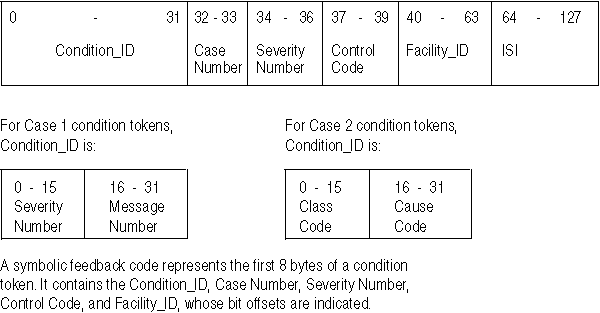The feedback code is an optional parameter of the Language Environment APIs. For C/C++ applications, this parameter is optional. For more information about feedback codes and condition tokens, see z/OS Language Environment Programming Guide for 64-bit Virtual Addressing Mode.
When you provide the feedback code (fc) parameter, the API in which the condition occurs sets the feedback code to a specific value called a condition token.
The condition token does not apply to asynchronous signals. For a discussion of the distinctions between synchronous signals and asynchronous signals with POSIX(ON), see z/OS Language Environment Programming Guide for 64-bit Virtual Addressing Mode .
When you do not provide the fc parameter, any nonzero condition is signaled and processed by Language Environment exception handling routines. If you have registered a user-written exception handler, Language Environment passes control to the handler, which determines the next action to take. If the condition remains unhandled, Language Environment writes a message to stderr. The message is the translation of the condition token into English (or another supported national language).
Language Environment provides APIs that can be used to convert condition tokens to routine variables, messages, or signaled conditions. The following table lists these Language Environment APIs and their functions. For more information on these APIs, see z/OS XL C/C++ Programming Guide.
| API description | |
|---|---|
| __le_msg_write() | Writes a message string to stderr |
| __le_msg_get_and_write() | Takes a message associated with a condition and writes it to stderr |
| __le_msg_get() | Retrieves, formats, and stores message data for a condition |
| __le_msg_add_insert() | Creates a message insert |
There are two types of condition tokens. Case 1 condition tokens contain condition information, including the Language Environment message number. All Language Environment APIs and most application routines use case 1 condition tokens. Case 2 condition tokens contain condition information and a user-specified class and cause code. Application routines, user-written exception handlers, assembler user exits, and some operating systems can use case 2 condition tokens.

- X'0003' is severity.
- X'032D' is message number 813.
- X'59' are hexadecimal flags for case, severity, and control.
- X'C3C5C5' is the CEE facility ID.
- X'00000000 00000000' is the instance specific information (ISI). (In this case, no ISI was provided.)
If a Language Environment traceback or dump is generated while a condition token is being processed or when a condition exists, Language Environment writes the runtime message to the condition section of the traceback or dump. If a condition is detected when a Language Environment API is invoked without a feedback code, the condition token is passed to the Language Environment condition manager. If a condition is severity 0 or 1, Language Environment resumes without issuing a message. For conditions of severity 2 or greater, Language Environment issues a message and terminates. For a list of Language Environment runtime messages and corrective information, see z/OS Language Environment Runtime Messages.
If a second condition is raised while Language Environment is attempting to handle a condition, the message CEE0374C CONDITION = <message no.> is displayed using a write-to-operator (WTO). The message number in the CEE0374C message indicates the original condition that was being handled when the second condition was raised. This can happen when a critical error is signaled (for example, when internal control blocks are damaged).
If the output for this error message appears several times in sequence, the conditions appear in order of occurrence. Correcting the earliest condition can cause your application to run successfully.